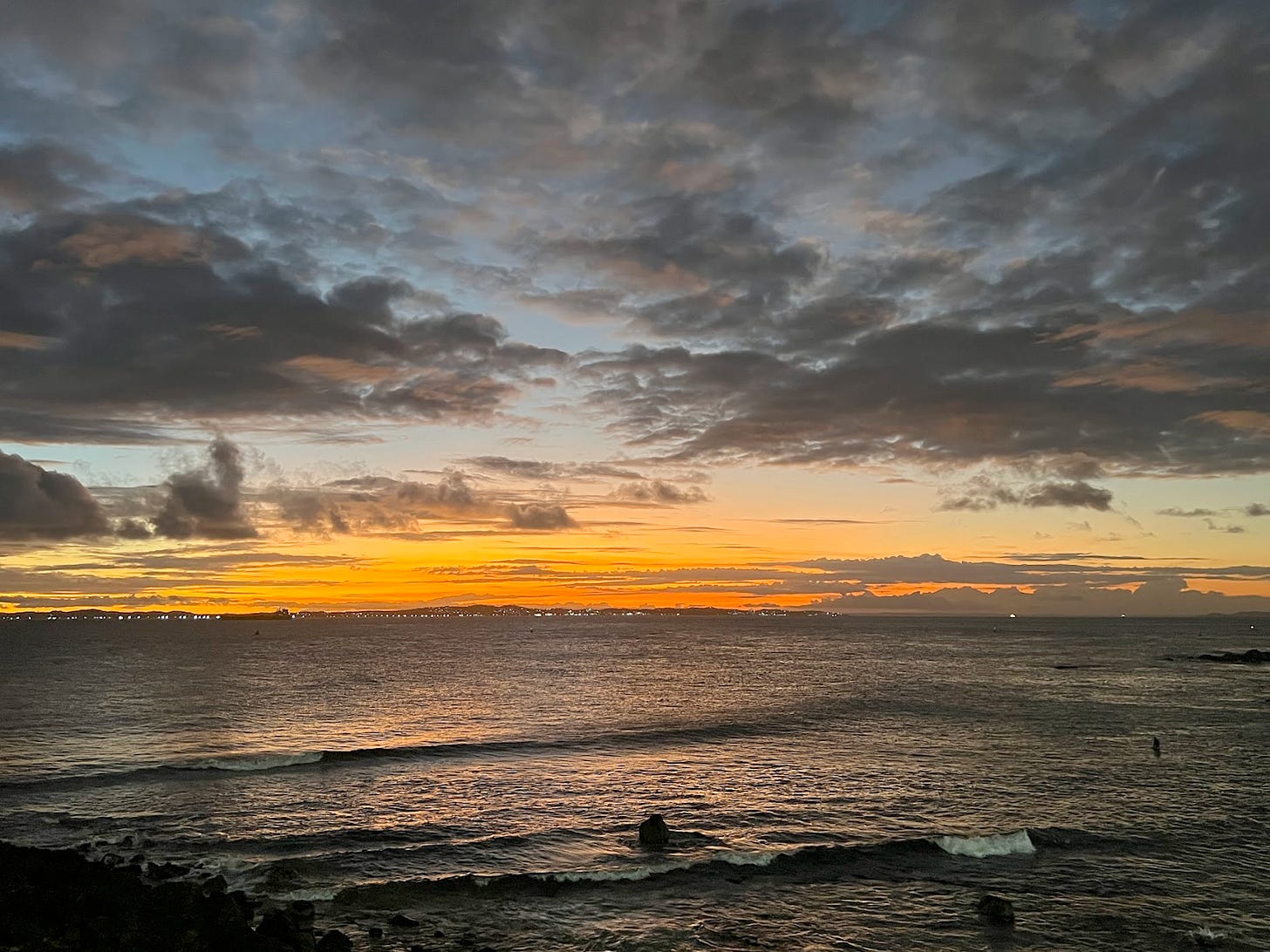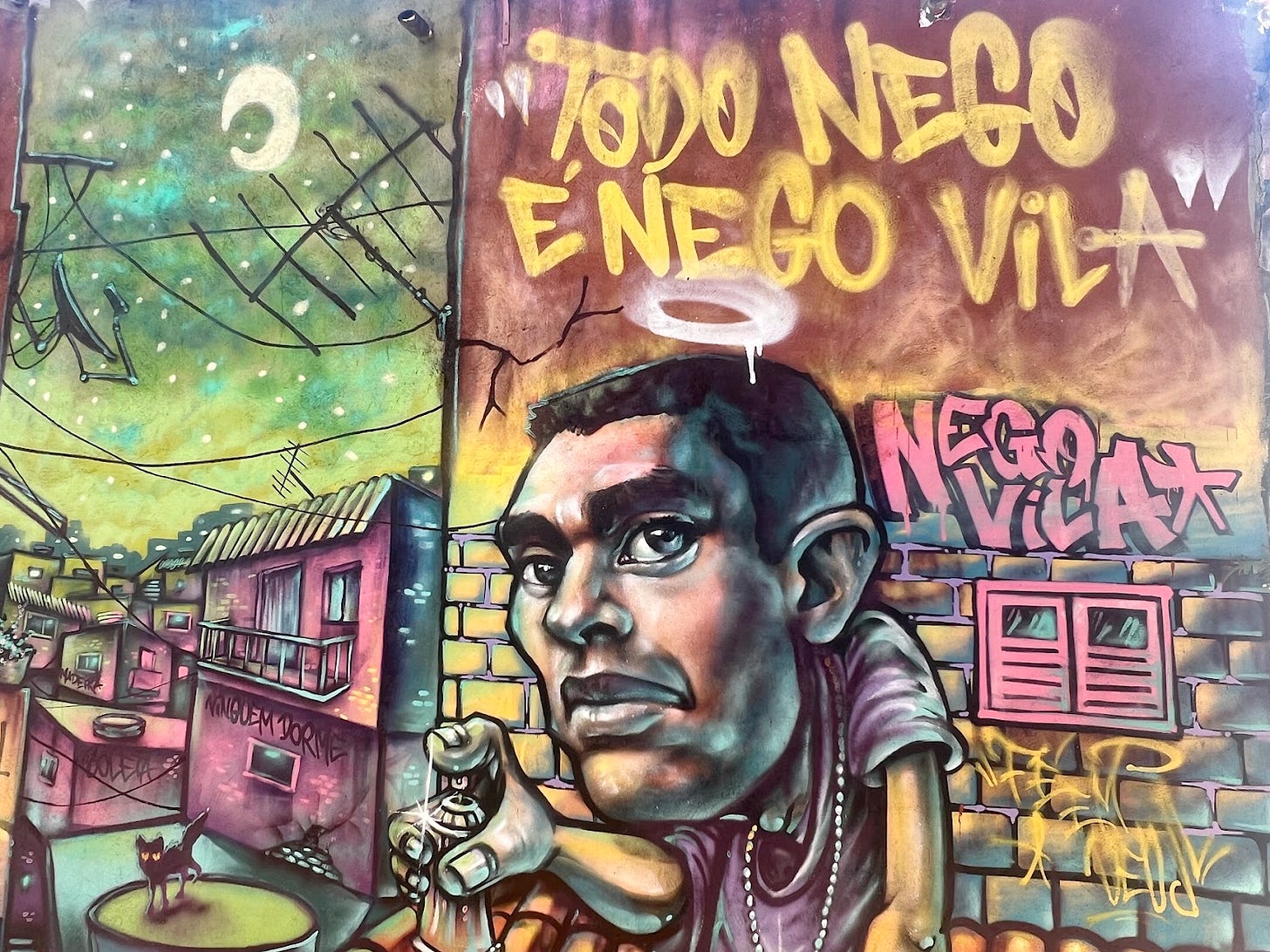Of Sun, Samba, & the Shadows of Slavery - Part II
A journey of colors and contrasts in Brazil.
The second leg of my journey through Brazil began in Salvador de Bahia. Recommended by my South American colleagues as a ‘must-visit’ destination due to its cultural and historical significance, Salvador promised to offer a deeper glimpse into Brazil’s Afro-Brazilian roots.
As the first colonial capital of Brazil, Salvador was a central hub for the transatlantic slave trade, and much of the city’s cultural heritage is rooted in the Afro-Brazilian communities that emerged from this painful history. It was here that millions of enslaved Africans were brought to work in the sugar plantations, mines, and cities, forging a culture that blends African, Portuguese, and Indigenous traditions.
Salvador is also the birthplace of capoeira, the Afro-Brazilian martial art-dance, and the rich culinary traditions of the region, influenced by African and Indigenous cultures, shine in dishes like moqueca (fish stew) and feijoada (black bean stew).
Soaking in the Coastal Vibes of Barra
My first day in Salvador was spent exploring Barra, the neighbourhood where my Airbnb was located. Now traveling solo, I wanted to take things slow, do my laundry, and absorb the serenity of the coastline before diving into the city’s history and culture. Praia do Porto da Barra (Barra beach) and Farol da Barra (Barra Lighthouse) were just around the corner, and I spent the evening sitting by the lighthouse, watching the sun go down over the Atlantic Ocean.
A Colourful Walk Through Pelourinho
On my second day in the city, I went for a walking tour with Icaro. We walked through Pelourinho, a UNESCO World Heritage site and the historic centre of Salvador. The brightly painted colonial buildings, soulful beats of drum circles, and rituals of Candomblé—the Afro-Brazilian religious tradition—are all testament to the enduring strength of the African-descended people who, despite centuries of oppression, kept their culture alive.
But the neighborhood is also an example of gentrification. Many of the original residents of the neighborhood have been evicted to the outskirts of the city and have to commute for hours daily to get to work. Their homes have been converted into shop houses selling souvenirs and most of the top floors of the shops remain vacant.
We meandered through the narrow cobbled streets, observing the various kinds of architecture, as Icaro told us about Pierre Verger–a famous Franco-Brazilian photographer, the gold-leaf interior of the São Francisco Church, Bahian culture, and more. I couldn’t visit the Casa do Carnaval (Museum of Brazilian Carnival) but I managed to grab a scrumptious bite—Moqueca (seafood stew)—at Cuco Bistrô.
Learning Samba Beats at Cidade Da Música
Speaking of Bahian culture, music is an integral part of Bahian identity and form of spiritual expression, so I made sure to visit Cidade Da Música (Museum of Brazilian Music) on the recommendation of my friend, Sofia. Although I didn’t understand a lot because most of the written and audio content was in Portuguese, it was a pleasure to experience a museum like this. There were three floors dedicated to different themes: Level 1 featured booths with videos about the musical heritage of different neighborhoods of Salvador; Level 2 featured interviews and footage of the various influences on Brazilian music: from writers and social movements to historical events and local culture; and Level 3 was an interactive space with live workshops. I got to attend a free percussion workshop and learned to play samba beats on various instruments—something I thoroughly enjoyed.
On Sofia’s recommendation, I also visited Solar do Unhão—a house designed by Lina Bo Bardi, an Italian-born architect who became one of Brazil's most celebrated modernist designers. Lina is said to have embraced the country’s diverse cultural influences, blending modern architecture with local traditions and materials, and advocated for the social responsibility of architecture.
Located along the city's waterfront, the structure of Solar do Unhão seamlessly combines colonial-era architecture with contemporary elements, and now houses the Museum of Modern Art. It has many similarities with Goan-Portuguese architecture, and for a moment it felt like I was back home in Goa.
36 Hours in São Paolo
My final destination in Brazil was São Paulo, where I had 36 hours to catch my breath, see what I could, meet my Brazilian flatmate from Uni after nearly 12 years, and rush to the airport to fly back home. After Guarujá, Rio, and Salvador, São Paulo felt like a shift. Known as the financial capital of Brazil, it’s an urban metropolis, where the sky is often hidden behind towering skyscrapers. The high-end restaurants and art galleries coexist with street art reflecting the city’s rebellious side, reiterating the many colors and contrasts of Brazil.
Morning at Museu Afro Brasil
One of my first stops in São Paolo was at Museu Afro Brasil (the Afro-Brazilian Museum). Dedicated to preserving Afro-Brazilian history and culture, the museum showcases a vast collection of artwork, sculptures, historical objects, textiles, furniture, religious idols, photographs, and installations that highlight the influence of African culture on Brazilian history, art, and society.
What I loved most about the museum though is that it’s located bang in the middle of Ibirapuera Park that spans over 1,000 acres! The stunning heritage trees and tranquil lake offered the perfect getaway from the city's hustle-bustle and made for an idyllic reading nook for the day—one that I will remember for a long time.
Of Art and Architecture
My next stop was the Museum of Art of São Paulo (MASP), another Lina Bo Bardi creation. An iconic example of modernist architecture, its striking design features a massive glass and concrete structure elevated by two lateral beams, creating an open space underneath that has become a landmark of São Paulo’s skyline. The museum’s innovative use of space and materials was revolutionary for its time, offering a unique and flexible environment for art displays.
Since I happened to visit the museum on a Tuesday, the entry is free, and I not only got to see the usual art exhibits but also a special Monet exhibition.
Art is Political
After my visit to MASP, I was excited to immerse myself in the art of the streets. I signed up for a free graffiti and street art walking tour through Vila Madalena. Led by Eli, our guide, we learned how graffiti became popular in the late 70s/early 80s in response to dictatorship—a movement to question dominant narratives and power using the streets. Vila Madalena became popular for street art due to the high concentration of universities in the neighborhood. The area is also filled with bars that became popular during the Football world cup.
She shared that unlike other cities, there are several women and trans street artists in São Paolo who would go out together at night to practice. She also enlightened us about the difference between street art, murals, and Pixo based on the artistic style, intent, and whether or not it is commissioned by someone. Stickers are also considered street art in São Paulo.
While street art is done out of passion and the person who paints first is considered the (artistic) owner of the wall, murals are commissioned by the owner of the property and can erase it whenever they want. Pixo, on the other hand, is a style of street tagging that originated in São Paulo and is characterized by its quick, chaotic, and often highly stylized form of writing, usually created with spray paint, markers, or makeshift tools. It is considered as vandalism by some, encouraging a culture of disregarding social rules. The movie Pixo explores the nuances of the movement.
We walked through the many alleys of Pinheiros and Vila Madalena, stopping every now and then to appreciate the art on the walls. We spent some time at a basketball court surrounded by street art done by Familia Beco commemorating Nego, a Black Man who was shot by a police officer while off-duty in 2020. The incident became symbolic of police brutality and systemic racism in Brazil.
Familia Beco is a group of street artists and activists associated with Beco do Batman (Batman Alley), one of the most famous street art hotspots in Brazil. They painted the arena in protest of no serious action taken against the murder, after which the media started covering the case. The officer was arrested two years later and prosecuted for 15 years.
Beco do Batman is another alley that’s famous for its street art, chic boutiques, and pubs. It got its name because bats used to fly around the alley at night—but now also has batman symbols and graphics in different parts of the alley. With its ever-changing murals and street art, it has transformed into one of the world’s most famous open-air galleries.
But beyond its aesthetic appeal, Beco do Batman is also a symbol of resistance, community, and social activism, with many of the works reflecting themes like racial justice, politics, and urban life. It’s a must-see spot for art lovers and a powerful example of how public spaces can be transformed through art.
The Persisting Shadows of Slavery
The story of Brazil is not just one of cultural fusion and celebration—the legacy of racial inequality persists to this day. After the abolition of slavery in 1888, there were no significant efforts to integrate the formerly enslaved people into society. The transition was abrupt and unplanned, leaving millions of Afro-Brazilians without land, rights, or the means to support themselves. Instead of receiving reparations or a path to economic equality, the newly freed population was left marginalized. Afro-Brazilians continue to face systemic racism and are disproportionately affected by poverty, violence, and lack of access to education and healthcare.
Despite these deep-rooted challenges, there is an undeniable resilience and strength in Brazil’s Afro-Brazilian communities. From the vibrant energy of Salvador’s streets to the street art and murals in São Paulo, artists, activists, and common people are fighting to change the narrative using art, music, and community to reclaim space and voice in a society that often marginalizes them. This was evident in all the walking tours I did, where the guides didn’t shy away from talking politics and acknowledging Brazil’s uncomfortable truths, re-scripting the history they were taught in school, and educating us on the many facets and layers of the country’s past and present.
Traveling through Brazil taught me so much—not just about Afro-Brazilian culture and history—but also the importance of small efforts that push the country and its culture toward greater inclusion. It’s a reminder that change often starts small, in the spaces we inhabit and the people we meet. Something for us to learn and imbibe, don’t you think? :)






















So much to catch up on! But first
- Pics of non veg food are not match for the pic of fries, the one you clicked remember!
- I have missed so much but it is ironic that I read your post today when a Brazilian mate of mine has gone back to his country after he decided he has had enough of amreeka.
- how I love your pics Ila. What camera are you using? Are these processed? The one with a long shot and clouds just makes me want to eat fries. I swear.
Hamesha chakkey (rail wheels) lagey rahein tumhare pairon mein.
The street art is so good! And the context you share makes them all the more impressive.